Dell U3011 Review: Dell's New 30-inch Flagship
by Brian Klug on January 13, 2011 9:17 PM ESTViewing Angles
The U3011 has superb viewing angles, just like we've grown accustomed to seeing from IPS panels. Even at the far extreme horizontally, there's none of the purple I'm used to seeing from TN panels as you move off-axis. In the vertical direction, I saw the same thing with almost nothing to complain about. I did notice some glare at the extreme angles, but again that's dependent on where you're sitting and where light sources are located.
I think this is an excellent opportunity to talk about IPS graininess, something we really haven't discussed before. Of the IPS panels I've used to date, all of them have had some high frequency grain on the surface from a combination of coating and interference at the interface. Thankfully the U3011 has a combination antireflection coating and hard coating, and subjectively there seems to be less grain than I've seen on other displays.
Color Quality
Next up are the ever-important color quality metrics. As usual, we report two main quality metrics: color accuracy (Delta-E) and color gamut. Color gamut refers to the range of colors the display is able to represent with respect to some color space. In this case, our reference is the AdobeRGB 1998 color space, which is larger than the sRGB color space. Our percentages are thus reported with respect to AdobeRGB 1998, and larger is generally better unless you're dealing with sRGB content and colorspace-unaware software.
Color accuracy (Delta E) refers to the display’s ability to display the correct color requested by the GPU and OS. The difference between the color represented by the display, and the color requested by the GPU is our Delta-E, and lower is better here. In practice, a Delta E under 1.0 is perfect - the chromatic sensitivity of the human eye is not great enough to distinguish a difference. Moving up, a Delta E of 2.0 or less is generally considered fit for use in a professional imaging environment - it isn’t perfect, but it’s hard to gauge the difference. Finally, Delta E of 4.0 and above is considered visible with the human eye. Of course, the big consideration here is frame of reference; unless you have another monitor or some print samples like a Gretag Macbeth color checker card to compare your display with, you might not notice.
As I mentioned in our earlier reviews, we’ve updated our display test bench. We’ve deprecated the Monaco Optix XR Pro colorimeter in favor of an Xrite i1D2 since there are no longer up-to-date drivers for modern platforms. We're trying to find an i1Pro to use as well.
For these tests, we calibrate the display and try to obtain the best Delta-E we can get at both 200 nits of brightness for normal use, and 100 nits for print brightness. We target D65 and a gamma of 2.2, but sometimes the best performance lies at native temperature and another gamma, so we try to find what absolute absolute best-case performance for each display. We also take an uncalibrated measurement to show performance out of the box using either the manufacturer supplied color profile, or a generic one with no LUT data. For all of these, dynamic contrast is disabled, and displays are left to settle for a half hour after making changes. The U3011 is CCFL-backlit, and I used a settle time of 30 minutes accordingly.
First up is uncalibrated Delta-E performance. For this test, I took the monitor out of the box, connected it over DisplayPort, adjusted to 200 nits, and ran our usual GMB color checker test. Results aren't that great, sadly.
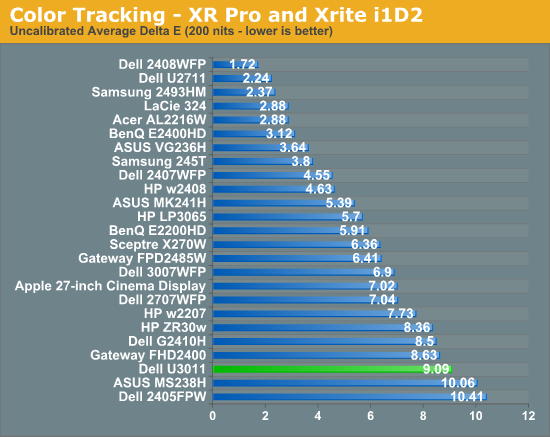
I mentioned earlier that the U3011 we got from Dell for testing came with no factory calibration report. After checking up with them, we learned this is a pre-production unit identical to what's shipping now, minus that factory calibration. That's something we can live with, especially since we recommend every display be calibrated, but still unnerving.
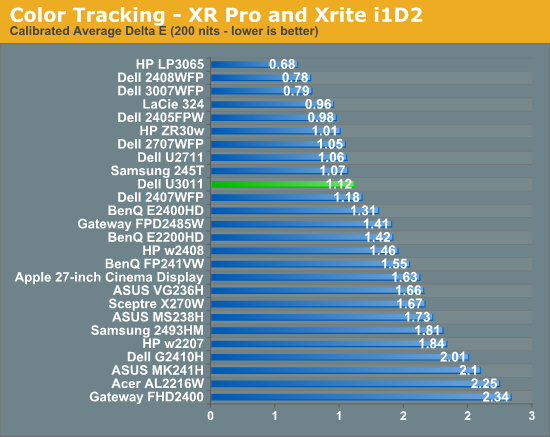
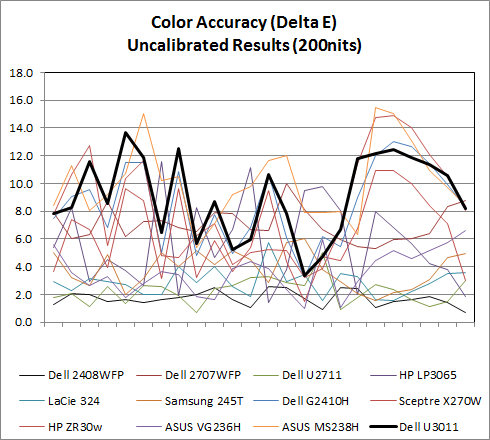
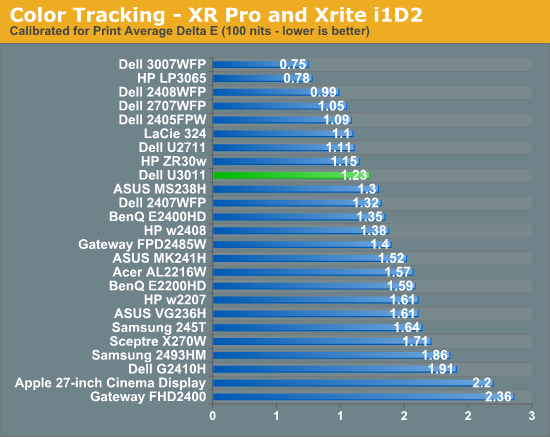
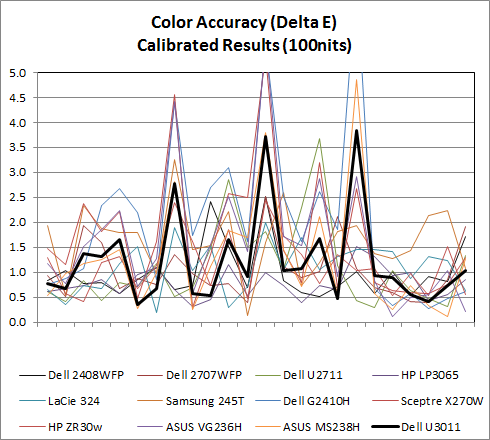
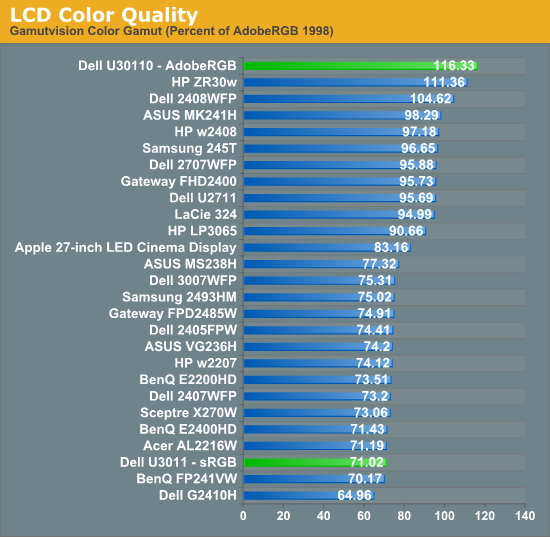

AdobeRGB Mode
sRGB Mode
Calibrated Delta-E is very good, though I'm still surprised the U3011 can't get under 1.0 on our tests. I'm starting to suspect that our i1D2 isn't quite as good as the Monaco Optix XR Pro, and have started looking for an i1Pro spectroradiometer as a result so we can have something more accurate going forward. That said, performance is still more than adequate for professional work. These two calibrations were performed in the sRGB mode at D65.
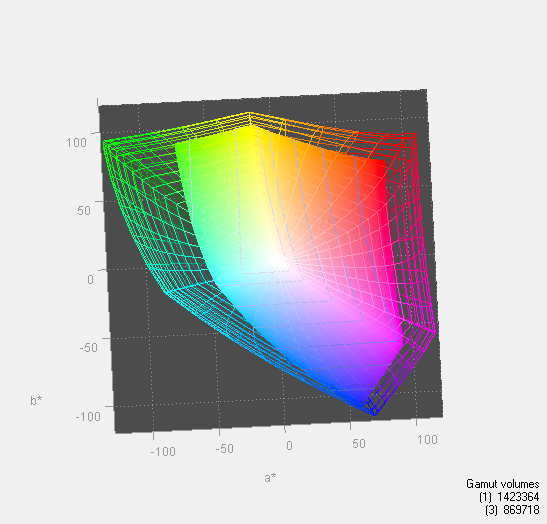
In addition, the U3011 has modes for AdobeRGB color space and sRGB in the OSD, something extremely useful for doing work and not getting oversaturation in applications that lack color management. You can immediately see the effect of those two modes in the color gamut measure above. Letting the monitor free to use its entire gamut of color, it leads the pack. Turn sRGB mode on, and it clamps down just nicely. 116.33% is also shockingly close to Dell's advertised 117% coverage of CIE 1796 (AdobeRGB), which is awesome to see confirmed above.








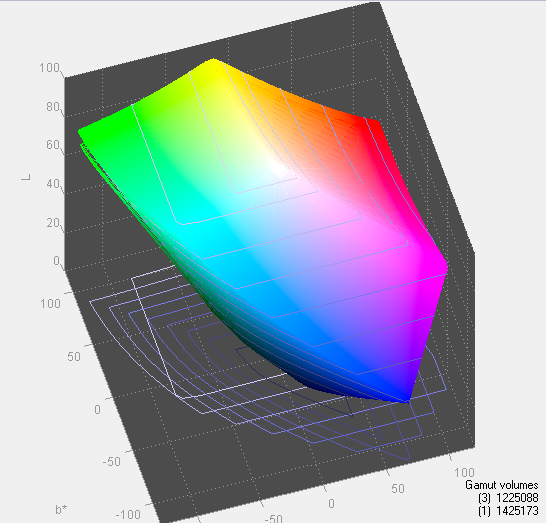
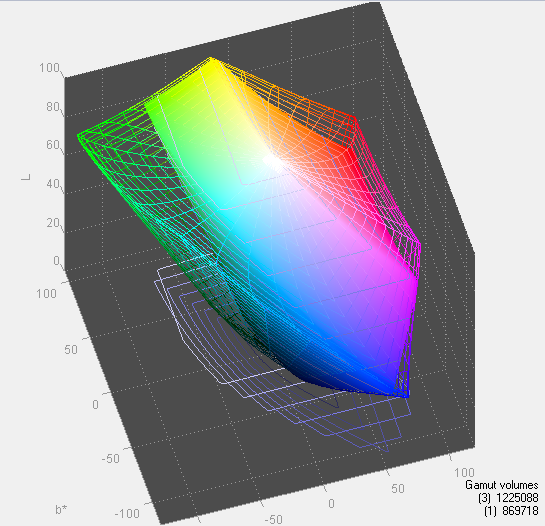








123 Comments
View All Comments
beachhead2 - Tuesday, January 18, 2011 - link
Dell outlet has these from time to time for $899. When they pop up, they go fast. I got one last week and it's top notch (coming from 2408WFP). I'm using it primarily for PS CS5. I calibrated it and I'm well pleased with my prints. Awesome display.godel - Wednesday, January 19, 2011 - link
It's a pity they didn't go to LED backlighting instead of CFL.The monitor is already over a thousand bucks, so a few extra dollars shouldn't matter much, and it would benefit greatly from a reduction in power consumption, as well as the reputed gains in picture quality that comes with LEDs.
cjl - Friday, January 21, 2011 - link
LED is a benefit for power consumption, but it can actually be a detriment to image quality. This monitor's CCFL backlight allows for a wider color gamut than WLED would, which is why they chose it.spilled - Thursday, January 20, 2011 - link
http://www.youtube.com/watch?v=qrjDbWU_43AGreat video showing the clear input lag winner. A shame... without the lag, and with the audio output, this would be a nobrainer for me. The limited inputs on the z30 make it less attractive, but still moreso I think.
As an aside, I did a similar comparison to this using my M6500 and a trusty dusty 2001FP I still have from 10 years ago. About 1/3rd of a window similar in size on that test behind for the old Dell.
Things have gotten better, but for $1300+, I think I'll sit the fence.
pkoi - Friday, January 21, 2011 - link
I really like seeing displays reviews benched with meaningful metrics.I want MORE,,,
iaw4 - Sunday, January 23, 2011 - link
why do all the 30" monitors miss speakers? (the DELL speaker bar for the 3008 is worse than my worst notebook computer. I don't need much, but the DELL speakerbar is really bad.) and yes, many people just like having a one-in-all monitor. heck, I would even like a webcam in it, but I understand that this is not a common need. I would also not tuner while we are at it, but again, this is not needed.
but speakers?? come on.
for lack of speakers you should subtract a half-star.
JonathanMEdwards - Monday, March 7, 2011 - link
DisplayPort has some problem with power management. Won't wake up after going to sleep. Too bad, it's a really sweet monitor visually.http://en.community.dell.com/support-forums/periph...
http://en.community.dell.com/support-forums/periph...
Manhar - Thursday, March 10, 2011 - link
The review states that there is no pivot mode.Are you sure that this has no pivot and cannot be used in portrait mode?
Dell have confirmed in writing to me that it can pivot and do the portrait mode!
voganville - Saturday, March 12, 2011 - link
I want to use two of these monitors side by side. I have an Nvidia GTS450. Will it work?ruzveh - Sunday, May 29, 2011 - link
I dont understand why 30" Monitor so expensive than usual 40" TV? Is it really worth buying a 30" TV than 42" or 46" high end TV at the same time? If resolution is not the priority or preference or use then better to go with TV than a monitor. Anyways we r still way behind the technology like how Anandtech rightly introduced us right at the start.